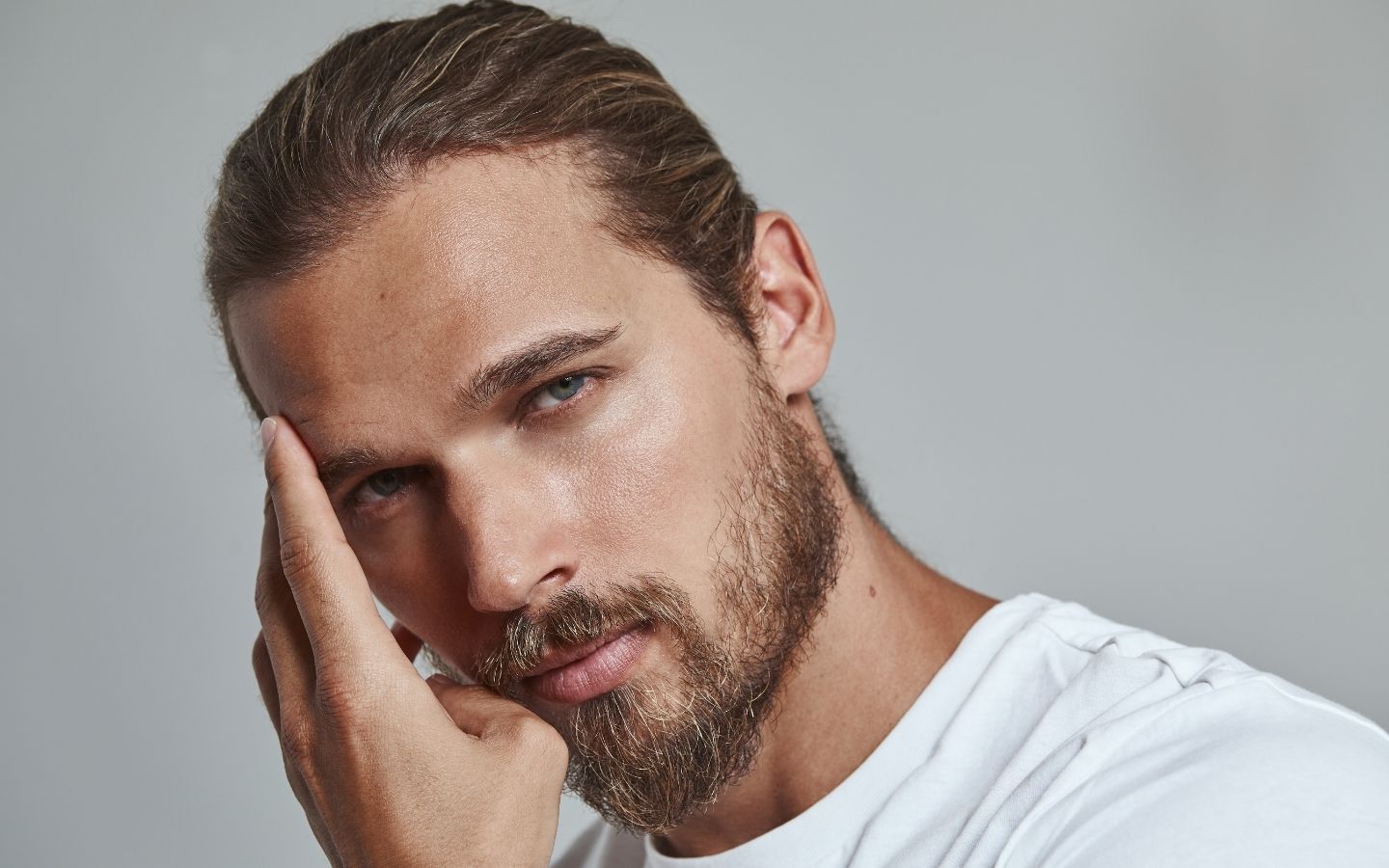
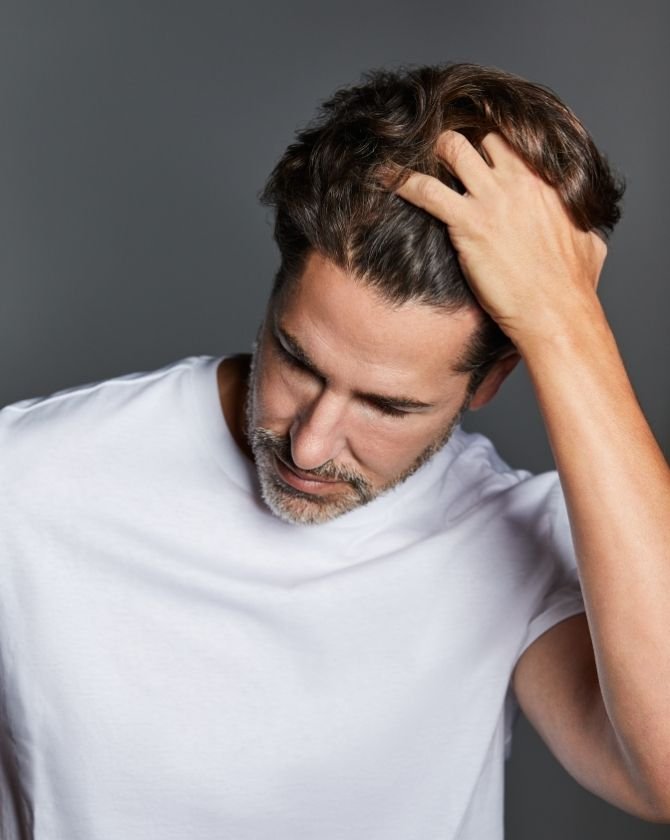
The word 'alopecia' comes from the Greek 'alopex' meaning 'fox'. It is by analogy with the abundant annual fall of this animal’s fur at the start of spring that the term "alopecia" was chosen to designate the loss of hair.
The term "baldness" refers to the total or partial absence of hair. This is the word used to describe the condition of a bald person. Baldness is the result of what is known in dermatology as alopecia, a phenomenon characterised by a significant and continuous loss of hair. A human being has between 100,000 and 200,000 hairs and naturally loses an average of 100 hairs per day. We speak of alopecia when this loss exceeds 100 hairs per day and is spread out over time.
Male pattern baldness can occur at any age, even in adolescence. As adults, the more years go by, the more likely a man is to go bald. Between the ages of 20 and 30, androgenetic male alopecia already affects 1 in 4 men. Among men in their forties and fifties, the trend is confirmed: 1 in 2 men suffers from baldness.
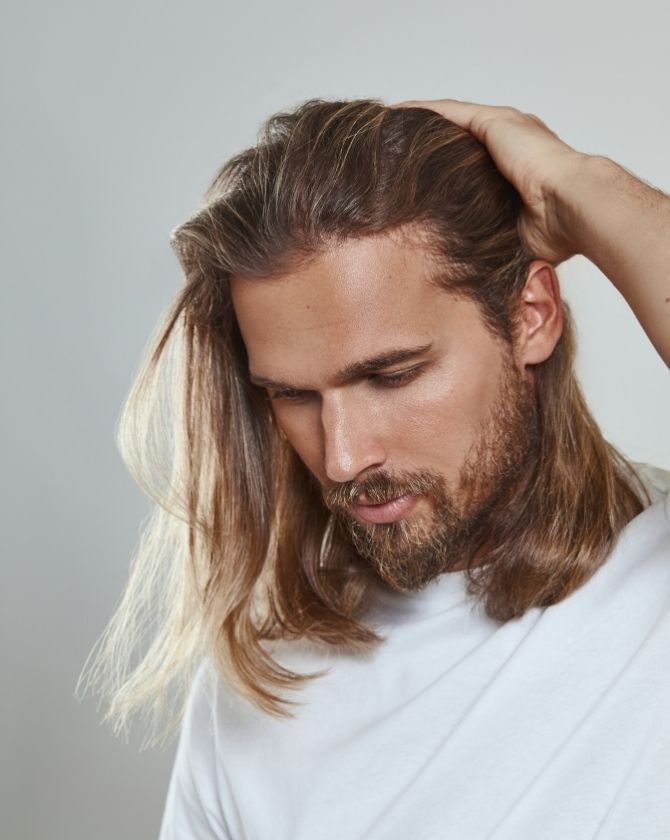
Many men are affected by abnormal and permanent hair loss. Approximately 13% of French people claim to be bald. And many of them have a hard time with this situation. Indeed, a man's hair is a symbol of his strength, youth, and self-confidence. As a result, baldness often causes men to have a physical complex, a loss of self-esteem, and sometimes even a profound sense of unease. Fortunately, there are solutions for combating hair loss and correcting baldness, even when it is in an advanced stage.
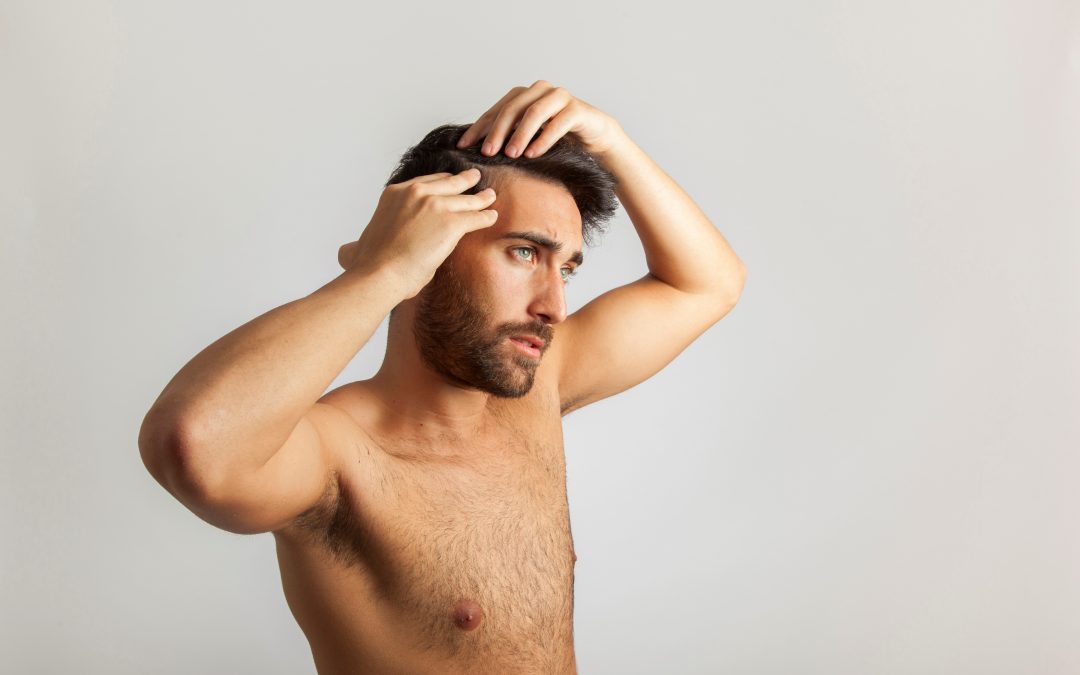
Various scientific studies seek to explain the causes of male pattern baldness. By analysing an individual's genetic make-up, it would then be possible to predict their propensity to lose their hair and become bald. Several dozen groups of genes have been identified, which originate from the father, but also from the mother. However, it is still difficult to determine which of the two parents passes on the "baldness gene", even though recent studies have suggested that it is the mother's genetic heritage that is mostly involved.
Hereditary baldness results in progressive hair loss, initially leading to a decrease in hair volume and density in certain areas, which become increasingly sparse.
Male pattern baldness is then characterised by a progressive clearing of these weakened parts of the scalp, often in the temporal and frontal gulfs – above the forehead and temples, from the anterior vertex to the top of the head. In these bald areas, the hair growth phase is shortened and accelerated to the point where the hair follicles exhaust their life cycle and the hair no longer grows back.
When hair loss is generalised, it is called diffuse alopecia. It is usually a sign of a disorder in the body, caused for example by intense stress, chemotherapy, endocrine problems, etc. In this case, hair implants are not the best solution. One should rather consider micropigmentation of the scalp.
Seasonal hair loss is normal and natural. Every time the season changes, in spring or autumn, we lose more hair than the rest of the year, sometimes by the handful. This is a form of reactive and transient alopecia.
The first signs of male pattern baldness usually appear at the age of 35 or 40. But alopecia can occur as early as 20 years of age, sometimes even in adolescence. This is called premature baldness. It is most often hereditary. In young men, baldness can be particularly difficult to deal with. Fortunately, there are various hair treatments available to accompany this type of baldness.
Incipient baldness corresponds to the early stages of development as characterised by the Norwood-Hamilton scale. Thinning temples, a growing forehead and a thinning bald spot are signs of the onset of baldness. Cutting your hair can be a solution to conceal and cope with the onset of hair loss. But this will not stop the phenomenon. The use of Minoxidil can slow down hair loss, it is also possible to carry out capillary MesoLED and platelet-rich MesoLED treatments.
Traction alopecia is the result of excessively tight or pulled hairstyles. The permanent tension on the hair destroys the keratin chains and weakens the hair shafts. The hair becomes brittle and breaks. And under the scalp, the roots are detached from their hair follicle.
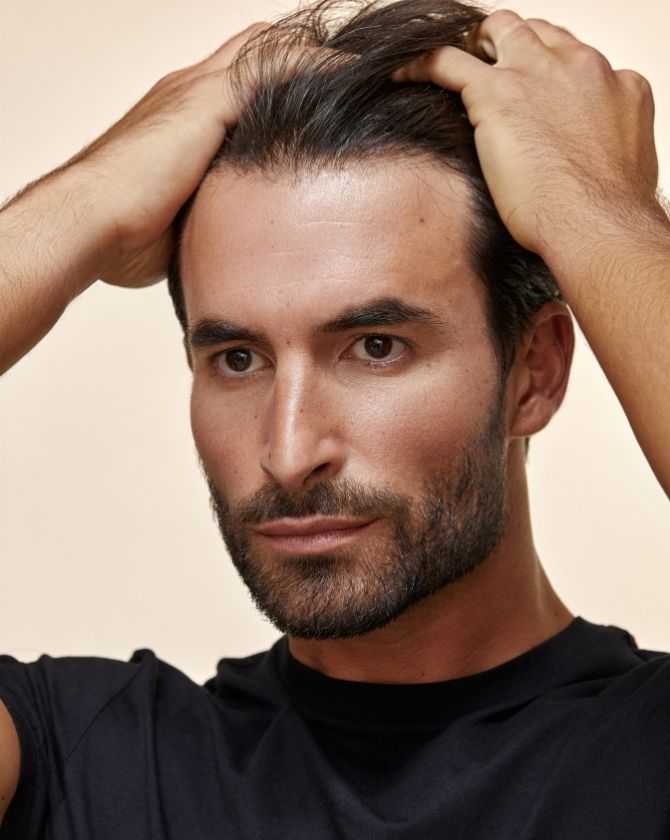
Various scientific studies seek to explain the causes of male pattern baldness. By analysing an individual's genetic make-up, it would then be possible to predict their propensity to lose their hair and become bald. Several dozen groups of genes have been identified, which originate from the father, but also from the mother. However, it is still difficult to determine which of the two parents passes on the "baldness gene", even though recent studies have suggested that it is the mother's genetic heritage that is mostly involved.
Hereditary baldness results in progressive hair loss, initially leading to a decrease in hair volume and density in certain areas, which become increasingly sparse.
Male pattern baldness is then characterised by a progressive clearing of these weakened parts of the scalp, often in the temporal and frontal gulfs – above the forehead and temples, from the anterior vertex to the top of the head. In these bald areas, the hair growth phase is shortened and accelerated to the point where the hair follicles exhaust their life cycle and the hair no longer grows back.
When hair loss is generalised, it is called diffuse alopecia. It is usually a sign of a disorder in the body, caused for example by intense stress, chemotherapy, endocrine problems, etc. In this case, hair implants are not the best solution. One should rather consider micropigmentation of the scalp.
Seasonal hair loss is normal and natural. Every time the season changes, in spring or autumn, we lose more hair than the rest of the year, sometimes by the handful. This is a form of reactive and transient alopecia.
The first signs of male pattern baldness usually appear at the age of 35 or 40. But alopecia can occur as early as 20 years of age, sometimes even in adolescence. This is called premature baldness. It is most often hereditary. In young men, baldness can be particularly difficult to deal with. Fortunately, there are various hair treatments available to accompany this type of baldness.
Incipient baldness corresponds to the early stages of development as characterised by the Norwood-Hamilton scale. Thinning temples, a growing forehead and a thinning bald spot are signs of the onset of baldness. Cutting your hair can be a solution to conceal and cope with the onset of hair loss. But this will not stop the phenomenon. The use of Minoxidil can slow down hair loss, it is also possible to carry out capillary MesoLED and platelet-rich MesoLED treatments.
Traction alopecia is the result of excessively tight or pulled hairstyles. The permanent tension on the hair destroys the keratin chains and weakens the hair shafts. The hair becomes brittle and breaks. And under the scalp, the roots are detached from their hair follicle.
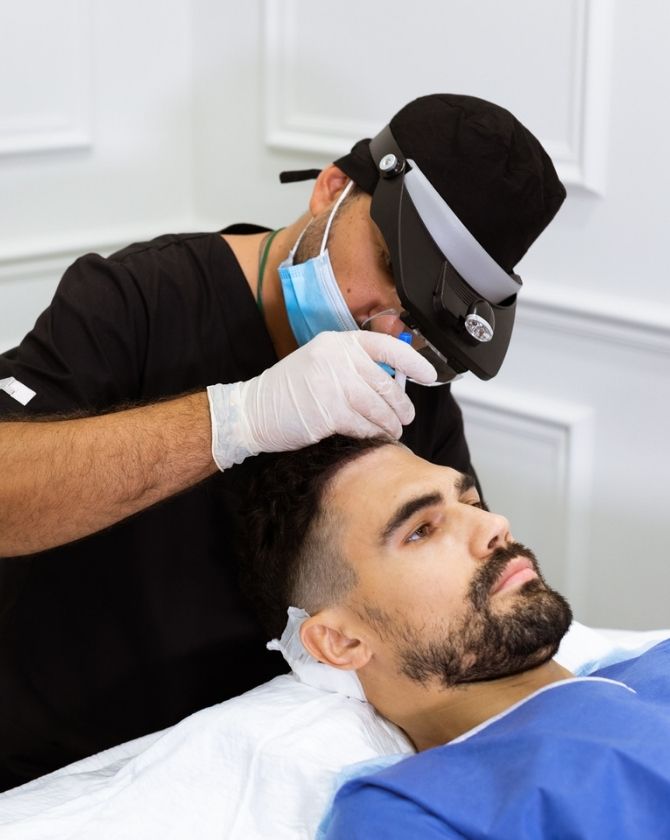
Various scientific studies seek to explain the causes of male pattern baldness. By analysing an individual's genetic make-up, it would then be possible to predict their propensity to lose their hair and become bald. Several dozen groups of genes have been identified, which originate from the father, but also from the mother. However, it is still difficult to determine which of the two parents passes on the "baldness gene", even though recent studies have suggested that it is the mother's genetic heritage that is mostly involved.
Hereditary baldness results in progressive hair loss, initially leading to a decrease in hair volume and density in certain areas, which become increasingly sparse.
Male pattern baldness is then characterised by a progressive clearing of these weakened parts of the scalp, often in the temporal and frontal gulfs – above the forehead and temples, from the anterior vertex to the top of the head. In these bald areas, the hair growth phase is shortened and accelerated to the point where the hair follicles exhaust their life cycle and the hair no longer grows back.
When hair loss is generalised, it is called diffuse alopecia. It is usually a sign of a disorder in the body, caused for example by intense stress, chemotherapy, endocrine problems, etc. In this case, hair implants are not the best solution. One should rather consider micropigmentation of the scalp.
Seasonal hair loss is normal and natural. Every time the season changes, in spring or autumn, we lose more hair than the rest of the year, sometimes by the handful. This is a form of reactive and transient alopecia.
The first signs of male pattern baldness usually appear at the age of 35 or 40. But alopecia can occur as early as 20 years of age, sometimes even in adolescence. This is called premature baldness. It is most often hereditary. In young men, baldness can be particularly difficult to deal with. Fortunately, there are various hair treatments available to accompany this type of baldness.
Notre solution capillaire complémentaire MésoLED, par mésothérapie et biomodulation, régénère, nourrit et hydrate en douceur le cuir chevelu, pour stimuler la repousse et revitaliser la chevelure.
D’une part, la mésothérapie capillaire consiste à nourrir directement l’écosystème du cheveu avec un cocktail de vitamines, d’acide hyaluronique et de nutriments essentiels à la bonne santé du cuir chevelu, des bulbes, des follicules et de la fibre capillaire.
D’autre part, sous l’action régénératrice de la lumière LED, la luminothérapie capillaire revitalise vos cheveux. Grâce aux effets combinés de ces deux procédés, notre traitement capillaire pour homme MésoLED offre une chevelure plus dense et plus forte.
Pour ce qui est de la MésoLED plaquettaire, ce traitement consiste à prélever le plasma directement issu du corps du patient à partir d’une prise de sang. Il est isolé des globules rouges et blancs, en vue de le réinjecter dans le cuir chevelu. Reconnues pour leurs propriétés réparatrices et régénératrices, les injections de plasma permettent de ralentir la chute de cheveux et d’activer la repousse.
There are different stages in the development of male pattern baldness. The degree of baldness progression is measured on the Norwood-Hamilton scale. It highlights 7 stages of alopecia, the last of which is characterised by the total and definitive absence of hair on the anterior forehead, anterior vertex and vertex. Only the temples and the lower part of the neck (Hippocratic wreath) are still covered with hair. Based on these criteria, we can establish a precise diagnosis and determine a suitable hair treatment plan.
The life cycle of a hair takes place in three successive phases over several years:
● The anagen phase: this is the period of growth, it concerns 85% of our hair and lasts between 2 and 5 years. The hair grows about 2 mm per week.
● The catagen phase: this is a short period of about 15-20 days during which the hair stops growing. The root goes up to the epidermis, but the hair remains attached to its hair follicle. Only 3% of our hair is in the catagen phase.
● The telogen phase: for 6 to 7 months, about 12% of our hair is at rest. They detach from the hair follicle and fall out naturally. Under the skin, a new hair can take root in the follicle and the cycle starts again.
In a lifetime, we experience about 25 such cycles.
Maison Lutétia offers a range of solutions resulting from 50 years of hair research to treat male pattern baldness.
In order to treat male androgenic alopecia, it is necessary to consult a hair specialist in order to implement a suitable solution. At Maison Lutétia in Paris, our experts welcome, advise and treat patients suffering from male pattern baldness. Our specialist doctors offer the most appropriate hair treatment for each form of alopecia to stop hair loss, regenerate bald areas and activate the natural regrowth process.
Our hair treatments for men allow us to meet every hair need, whatever the stage of your androgenetic alopecia, discreetly and painlessly.
Simple everyday gestures
Independently of or in addition to a hair treatment for men, a healthy, stress-free lifestyle and a healthy diet are necessary for healthy hair. To prevent and slow down hair loss, follow these tips:
● Adopt a balanced, healthy and varied diet, giving priority to vitamin B (fish, eggs, offal, dairy products, dried or green vegetables, hazelnuts, etc.)
● Take care of your scalp: massage before shampooing to activate blood circulation and encourage regrowth, use gentle and appropriate care products (anti-hair loss products), rinse hair with warm water and dry it gently, without rubbing or wringing out...
● Filling mineral needs: for example with food supplements rich in calcium, magnesium, zinc...
● Avoid products that are too aggressive, protect your hair from the sun.
Cosmetic treatments
Various hair solutions are marketed to limit or stop hair loss in men. A nourishing shampoo, a revitalising lotion, ampoules, a revitalising oil or anti-hair loss capsules can be useful in addition, to give life to damaged hair, stimulate a weakened scalp or strengthen brittle hair. However, this type of secondary hair care is insufficient to stop excessive and prolonged hair loss in men.
Drug treatments
Today there are several medications that slow down hair loss and correct baldness. Not all of them are without side effects, such as finasteride (Propecia® or Proscar®). Minoxidil, applied topically as a serum or foam, is a vasodilator that increases blood flow and helps oxygenate and nourish the hair follicles, thereby promoting growth and slowing hair loss.
Both can be combined as part of a drug treatment for baldness. They can also be prescribed as a complement to a hair transplant. In all cases, medical advice is required.
The skull tattoo
Also called tricopigmentation, this scalp tattoo can help a man deal with baldness by giving the illusion of a shaved head, thanks to the drawing of small dots all over the head. Micropigmentation allows to harmonize the hair discreetly, to give an effect of density thanks to the play of shades. This solution offers a natural and lasting result.
Baldness can be a source of embarrassment for many men. And several celebrities, French or international, have undergone hair transplants. This is for instance the case of Rafael Nadal, Florent Pagny, Marc-Olivier Fogiel, Nicolas Cage, Laurent Baffie, Evan Fournier and Sam Smith. Aesthetic medicine is now becoming less of a taboo. You too can call on Maison Lutétia and its exclusive method to benefit from tailor-made treatments carried out by expert doctors.
Male pattern baldness can occur at any age, from adolescence onwards for the younger ones. As adults, the more years go by, the more likely a man is to go bald. Between the ages of 20 and 30, androgenetic male alopecia already affects 1 in 4 men. Among men in their forties and fifties, the trend is seriously confirmed, with 1 in 2 men suffering from baldness.
Various hair solutions are marketed to limit or stop hair loss in men. A nourishing shampoo, a revitalising lotion, anti-hair loss capsules can be useful as a complement, to maintain damaged hair, stimulate a weakened scalp, strengthen brittle hair. However, this type of secondary hair care is insufficient to stop excessive and prolonged hair loss in men.
In order to treat male androgenic alopecia, it is necessary to consult a doctor specialised in hair and the hair system, in order to set up a suitable and professional solution.
Independently of or in addition to a hair treatment for men, a healthy, stress-free lifestyle and a healthy diet with foods rich in vitamin B, iron, zinc and magnesium are obviously necessary for good hair health.
Our experts welcome, advise and treat patients suffering from male pattern baldness at the Maison Lutétia DHI in Paris. Our specialist doctors offer the most appropriate hair treatment for each form of alopecia to stop hair loss, regenerate bald areas and activate the natural regrowth process.
Losing a limited amount of hair is normal and natural for a man. Consistent hair loss, at a rate of over a hundred a day, can be a sign of male pattern baldness. Many men are affected by abnormal and permanent hair loss, which can be difficult to live with.
A man's hair is a symbol of his strength, his youth, his virility, his masculine pride. As a result, baldness often causes men to have a physical complex, a loss of self-confidence, and sometimes even a profound sense of unease.
There are different types of male alopecia, the scientific name for hair loss. The most common in men is baldness, or hereditary androgenetic alopecia. It results in progressive hair loss, initially leading to a decrease in volume and density of the hair in certain areas, which become increasingly sparse.
Male pattern baldness is then characterised by a progressive clearing of these weakened parts of the scalp, often in the temporal and frontal gulfs – above the forehead and temples, or the vertex – at the top of the head. In these bald areas, the hair growth phase is shortened and accelerated to the point where the hair follicles exhaust their life cycle and the hair no longer grows back.
The Norwood-Hamilton scale is used to classify the different stages of baldness in men. At the end of the male androgenetic alopecia process, all the hair on the upper part of the head has permanently fallen out. The remaining hair only covers the lower part of the neck and the temples. Fortunately, there are treatments for male pattern baldness for men who suffer from it.

